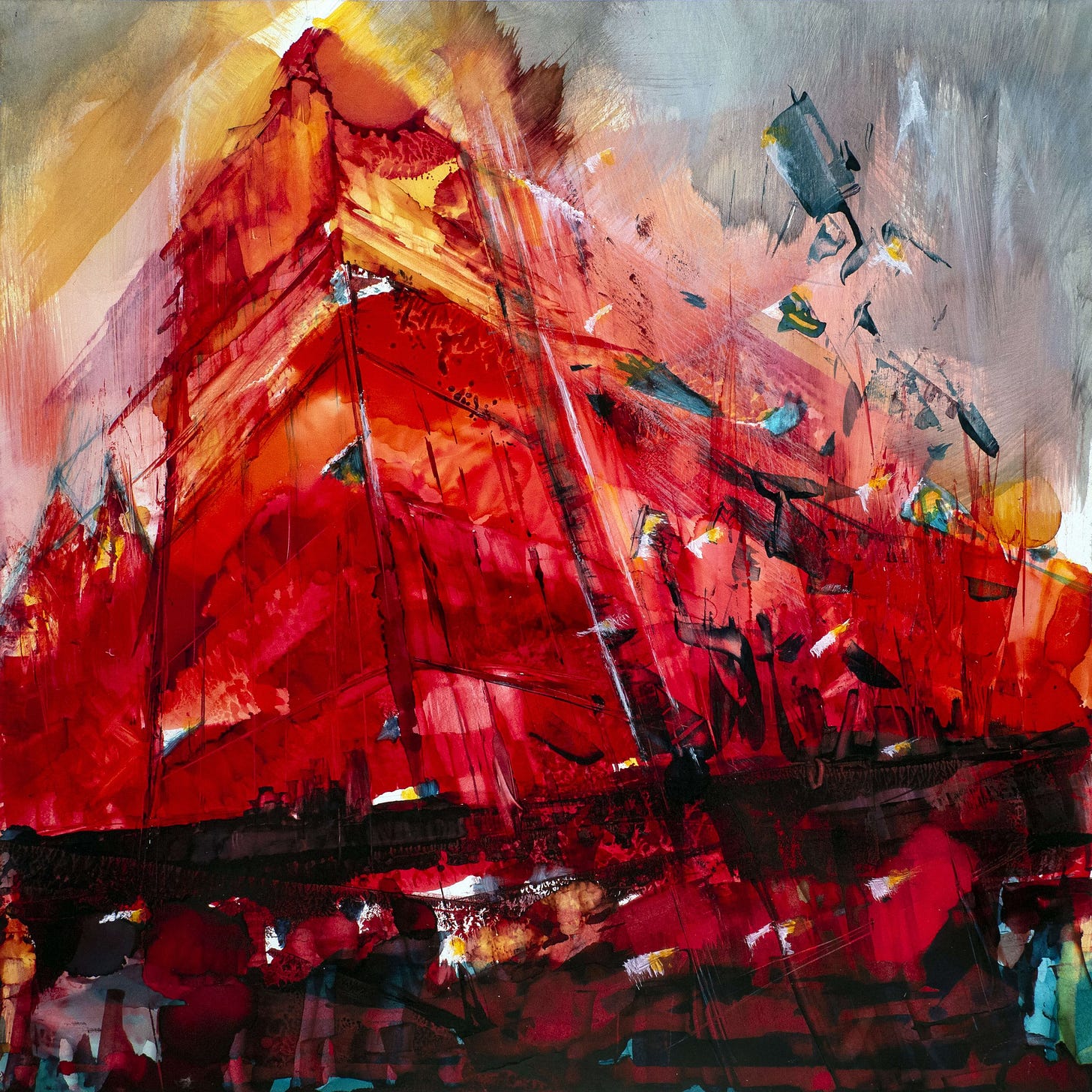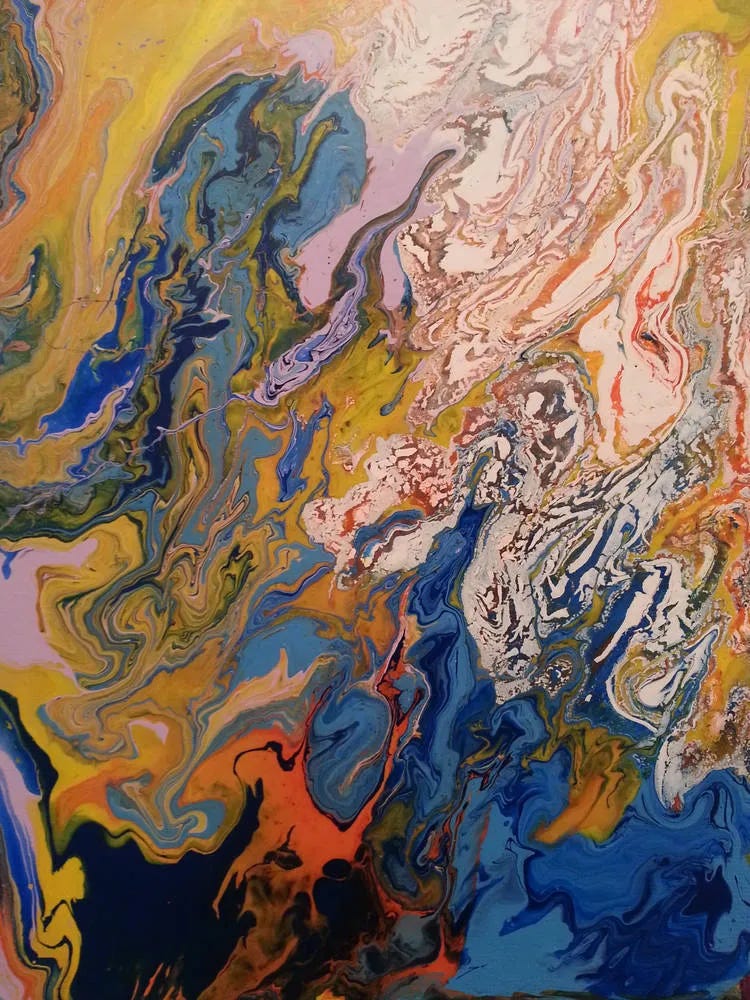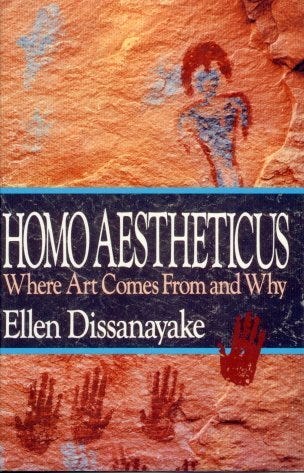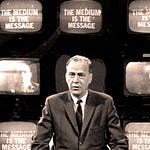This post started as the first draft of a message to subscribers spoken into Otter.ai. The first entry below is an edited and annotated transcript of the recording. I offer the transcript only as a convenience to time-starved readers who prefer to “get to the point”. However, for a rich-media experience, you would need to endure the full 23-minute audio recording, in which I discuss “the matter with the media”. Specifically:
The search for quiet places in our noisy media ecology, and
The upcoming post with a paragraph-by-paragraph reading of Chapter 4 of Marshall McLuhan’s Understanding Media.
Sometimes, we're fortunate enough to find the quiet places when we need them. The second entry below points to ways of responding to the “true sound” leading us to these places. The puzzle is that we only hear it in the quiet places. Do you hear the paradox? We can’t get there unless we hear the true sound, and we can’t hear the true sound unless we’re already there.
Perplexed? Let me guide you to the party at the end of time, where all will be made clear. It’s a dance party. The second entry below provides initial details. The location has already been selected. The time is set.
The final entry below provides links to my recent readings.
1. Transcript: Edited and Annotated
Looking for a Quiet Place
I could only offer you this post as an audio file because what you hear in the background is very much part of the story. I wanted you to hear what kind of noise I had to walk through to get closer to a quiet place.
I'm still walking, and I guess I'm inviting subscribers to join me on this walk. It won't be long. I'll need to close this file in no more than 30 minutes.
The noise is part of the story because the story is, in large part, about our noisy media environment. It was already noisy when I started writing about it circa 2012. But now it's deafening. So it's gonna take me some time to just find an appropriate place and let the noise kinda wash out of my system.
I'm reporting from Kew Gardens, Queens. I'm approaching the park. What is this park called? I don't even remember. [It’s Forest Park.]
Already feels much quieter but we're not there yet.
[Upon hearing a not-too-loud passing vehicle]
Even noise like this is a distraction.
The Ideal World
In an ideal world, I'd have a quiet place — a stable, quiet place where I can produce my audio content…but I don't. So I do what I can with my limitations. But as I said, the noise is part of the story.
Here, as in my writing, I increasingly feel that it's impossible to be heard through the noise.
Hearing Music
[Upon hearing music]
And sometimes you hear music in the background which is also part of the story. The music makes me think back to my time in the Caribbean: sunny beaches, cold beer, people dancing. This also makes me think that, like music, this story has a rhythm.
[Music fades]
And now it's fading into the background.
Assaulted by Noise, Arrival Interrupted
Ah, there it is, the quiet place!
Just give me a moment here. It does take a while — a few breaths — to let the noise wash out of the system.
[Upon hearing a passing motorcycle]
And then there are the motorcycles! And those cars with revved up engines!
Maybe this is relevant to the story in part because this is a piece of autoethnography and just an example of how the process works.
This report, for example, does point to an issue that may affect people worldwide, especially around laws, local ordinances governing all the rules around car engines.
How is it legal?!
What do you do?!
This kind of noise constitutes assault!
I remember a recent conversation with somebody about misophonia.
[See also hyperacusis.]
I do have pretty strong reactions to noise.
So yeah, any New Yorkers out there with any insights into what one can do about this kind of noise, I'd love to hear.
But of course, as most New Yorkers, or as many New Yorkers, I often think about, or fantasize about, moving. Moving to a quieter place. But I’m here for now. (All behaviors are compromise formations.)
Looking for a Panacea Dealer
In thinking about all my medications, remedies, elixirs, magic potions... One of the most effective remedies for the noise is the work I do on Substack. What I'm really doing is testing hypotheses about the quest for peace and quiet in a noisy media ecology.
Understanding Autoamputation
I'll come back to these themes but maybe one thing I can do here just to focus on what I'm writing, I can just say a few things about my upcoming post about Chapter 4 in Understanding Media: The Extensions of Man. (Narcissus as Narcosis: The Gadget Lover).
(Although I do have more of a love-hate relationship with my gadgets. It's really just what we misleadingly call the phone. It's not a phone.)
This is building on my last post [where I only focused on the beginning of Chapter 4]. But what I want to do in the upcoming post is provide a paragraph-by-paragraph reading of the entire chapter.
It's a short chapter, but I increasingly find that reading McLuhan doesn't work the way most reading does, often. This is definitely the kind of text that works best with — in fact, requires — a close reading. Slow, slow reading, so that's what I'm going to do in the next post.
Next Year at MISM
The upcoming post will later become a kind of a building block for the project I'm starting next year which is going to increasingly focus on MISM, my Substack focused on Understanding Media.
What I'll be doing there is basically what you'll see in the next post. That's what I’d like to do for all 33 chapters.
That's a big project, obviously, and I will turn those [chapter readings] into weekly posts available for free to anybody.
Yeah, that'll be one area of focus for next year.
I'm not sure how much time I'll have allocated for Substack next year, but this is definitely already in the works.
Comfort with Unfamiliar Experiences, New Sources
This is probably the longest audio post I've done so far. An unfamiliar experience for me.
Back to Chapter 4. There’s one part of the next post I’ll highlight here by way of preface. It is Psalm 115, which McLuhan identifies as 113, and I haven't yet figured out why. I'd welcome any input from any subscribers who have studied such matters.
So, what I read for the last post was the Sefaria translation of Psalm 115, but the version of the translation that McLuhan uses in the chapter is different. It's different, and I will use that version in the upcoming post because it’s more poetic, and maybe I’ll extract something helpful about what these differences in the translation reveal (found in translation), and I’ll look a bit at the Hebrew original, but I don’t promise you any major insights there.
When all is said and done, there’s always more to say and do.
Maybe I'll just wrap this one up.
Maybe I've said enough.
Or maybe not enough.
I don't know.
I think I'm going to start walking back.
Yeah, well, this wasn't gonna be longer than this.
Trying to think if there's anything else.
I guess not.
Anyway, subscribe.
What else?
Call to Action
What other calls to action?
Yeah, just subscribe.
Stay tuned.
2. Responses to True Sound: Beyond Ineffability
Speech and silence may be equally futile, but there's a time to speak and a time to be silent, a time to publish and a time to conceal — even in defiance of futility. Nothing needs to change as a result of the alternations of speech and silence. But something inevitably changes. Vibration creates resonance.
Abuzz in Resonance
Every blog post is a quest for resonance. Even if the resonance barely reaches beyond the author's “Audience of One”, it satisfies an irrepressible need: the need to keep looking and listening and sensing and moving.
That's why, after the discovery of the limits of language, we discover the limits of life without language. Beyond the limits of speech, we discover the limits of silence. When all is said and done, there's always more to say and do. This work continues until we die.
Until We Die
As long as we draw another breath, we continue the dance in the dialectic of sound and silence. But the dance acquires an ineffably different quality after the fiction of the dancer dissolves. Sometimes, this dissolution occurs before physical death, and the survivor begins to respond to life beyond ineffability.
At this stage, many survivors find their sound in the texts and practices of established traditions. They find ways to be seen and heard within the tabernacles of Buddhism, Sufism, Neo-Chasiddism or another ism that recognizes the dissolution of the fictive dancer.
Whether they anchor themselves in a tradition or pursue the path of self-initiation, the survivors don’t necessarily turn silent or “blissed out”. In fact, it is only after their journey past the limits of language — past the rubicon of ineffability — that they discover their true sound.
True Sound
The true sound doesn't come through words. If the writer is fortunate, he reaches readers who hear the sound between the lines of the text and feel its resonance in their interiority. Then, the arrangement of words no longer matters.
This only happens “between the lines” because true sound responds to the medium of the phonetic alphabet the way a water lily responds to its transplantation into desert sand. When the true sound survives this entrapment, it resonates.
I hear from sources I trust that this survival rate has been increasing exponentially, and our world is now abuzz in resonance.
Responses to Resonance
We can't help but respond to resonance. In mainland Europe between the 14th and 17th centuries, these responses often took the form of dancing manias. That's my best theory of the animating energy of choreomania (aka Tarantism or the Dancing Plague).

Neither history nor science provides a satisfactory account of this phenomenon. Both history and science are language-dependent pursuits. Dance, by contrast, transcends language. It responds to resonance. It requires no explanation.
Homo Aestheticus
No need to explain why we do what we do. We can simply notice that, in the Platonic triad of the good, the true and the beautiful, beauty offers the surest defense against violations of truth and goodness.
Don't take my word for it. Listen to Terence McKenna or James Hillman. Or read Ellen Dissanayake.
Making art is a biologically innate need as fundamental as the need for food, warmth or shelter, asserts Dissanayake, who teaches at Manhattan's New School for Social Research. In a provocative manifesto that extends the thesis of her previous book What Is Art For? she argues that art was central to human evolutionary adaptation and that the aesthetic faculty is a basic psychological component of every human being.
Invitations
Join me in a celebration of the awesome beauty of this moment on Monday, September 25, 2028. Admission is free. For further details, subscribe and email me at m2dialogue@substack.com and write “Let’s Dance” in the subject line.
Over the next year, I’ll be focused on raising funds for this event. If you’d like to support the cause, the easiest way to get started is to become a paying subscriber to DaaS. (FYI - I now offer collaborations in Otter.ai as a voice-first alternative to Slack.)
3. Recent Readings
The Sensory Order
How A Synesthetic Artist Sees Sounds And Turns Music Into Paintings (NPR)
The Alchemy of Synesthesia: A remarkable, luminous way of experiencing the world
The Ghost in the Machine
Noam Chomsky on AI, Neural Networks, and the Future of Linguistics (Dr. Brian Keating)
Noam Chomsky on the Ghost in the Machine (Machine Learning Street Talk)
The Digitized Self: AI, Identity and the Human Psyche (Machine Learning Street Talk)
MIT scholars awarded seed grants to probe the social implications of generative AI (MIT News)
Housekeeping
M2 Dialogue will be closed in observance of Yom Kippur.













Share this post